Introduction
Due to the history of colonialism concerning Indigenous people and its “politics of cultural genocide and assimilation,” Indigenous children were sent to residential schools where they were physically and psychologically abused, many Indigenous people and communities have been deeply damaged (The Truth and Reconciliation Commission of Canada, 2015, p. 183). The 94 Calls to Action were issued to call on all levels of the Canadian government to work together to reconcile the harm caused by residential schools. In this blog, I will critically analyze four of the 94 Calls to Action. The following sections will be my positionality and perspective, a summary of the Calls to Action that I will address, the analysis of each document, and the insights and application.
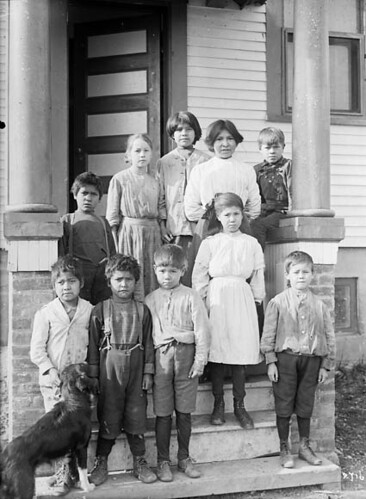
“Aboriginal students with a dog on the steps of an Indian School near Woodstock, New Brunswick / Élèves autochtones sur les marches d’une école indienne, avec un chien, près de Woodstock (Nouveau Brunswick)” by BiblioArchives / LibraryArchives is licensed under CC BY 2.0
Positionality and Perspective
After reading the Truth and Reconciliation Commission’s 94 Calls to Action and learning about Indigenous children’s experiences in residential schools, I believe that Indigenous people should have their rights back and that the Calls to Action need to be critically evaluated. As an Asian male in Canada, I understand the difficulty of living as a minority in a white-dominated society. Although I have limited knowledge of Indigenous culture and people, I can create new perspectives from this document. Alfred (2009) says,
What was stolen must be given back, and amends must be made for the crimes that were committed from which all non-Indigenous Canadians, old families and recent immigrants alike, have gained their existence as people on this land and citizens of this country. (p.182)
Due to this reason, it is necessary for me, as a non-Indigenous new immigrant, to be involved in critically analyzing the TRC Calls to Action. Moreover, when immigrants first arrived in Canada, they faced similar issues like injustices and discrimination (different extent of racism and oppression) that were experienced by residential school students (Truth and Reconciliation Commission of Canada, 2015, p. 306). Therefore, I will analyze the following documents from my positionality as a newcomer and minority person in Canada, with my previous working experience in a vocational center for immigrants.
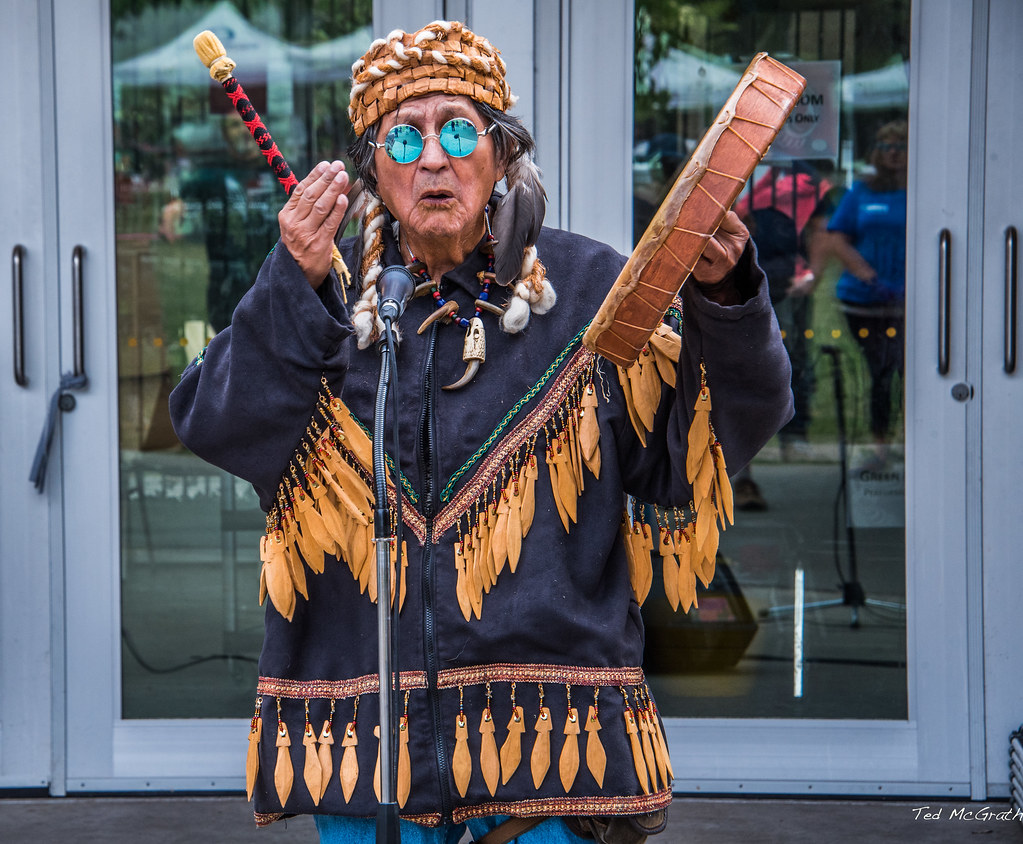
“2018 – Vancouver – National Indigenous Day Drummer” by Ted’s photos – Returns Early October is licensed under CC BY-NC-SA 2.0
Brief Summary of the TRC Calls to Action Addressed
I will analyze TRC Calls to Action #57, #63, #92, and #93 in this blog. They address the issues of educational equity and opportunity, job accessibility, and citizens’ intercultural competency, which are in the categories of education and business for reconciliation and Canadian immigration. Generally, those calls to action focus on calling upon developing curriculum related to Indigenous culture, “building student capacity for intercultural understanding” (Truth and Reconciliation Commission of Canada, 2015, p. 7), and training social workers and corporations for intercultural competency, including the history of Indigenous peoples and “the legacy of residential schools” (p. 10).
For more information about TRC Calls to Action, click the link and visit the official website.
Analysis of the Calls to Action
TRC Calls to Action # 63
We call upon the Council of Ministers of Education, Canada to maintain an annual commitment to Aboriginal education issues, including:
i. Developing and implementing Kindergarten to Grade Twelve curriculum and learning resources on Aboriginal peoples in Canadian history, and the history and legacy of residential schools.
ii. Sharing information and best practices on teaching curriculum related to residential schools and Aboriginal history.
iii. Building student capacity for intercultural understanding, empathy, and mutual respect.
iv. Identifying teacher-training needs relating to the above.
Strengths
By including the history of Indigenous people and the legacy of residential schools in the school curriculum, the hidden curriculum’s impacts can be minimized, hence the inclusion of school curriculum will be improved. First, the hidden curriculum, according to Nichols (1999, as cited in Castro & Sujak, 2014), includes the expectation from teachers, social networks among classmates, and other factors related to academic performance for all students. Most minority students might experience internalized stigmatization and discrimination as their differences from the majority (Castro & Sujak, 2014, p. 468). To solve those issues, adopting an inclusive curriculum and training faculty and administrators to serve those students’ needs are necessary. In this sense, this document helps Indigenous students with their academic performance in school by improving inclusion.
Second, implications and practices that lead to an equal learning environment could help educators develop inclusive teaching methods. The Universal Instructional Design, which means to “encourages faculty to make their classes more accessible to students with disabilities by developing curricula that are flexible and customizable” (Johnson & Fox, 2003, p. 9), provides an equal educational opportunity for both Indigenous students and non-Indigenous students, as they co-create learning communities “in which unique needs and diverse capacities are recognized, understood, accepted, and valued” (York-Barr & Vandercook, 1996, p. 3).
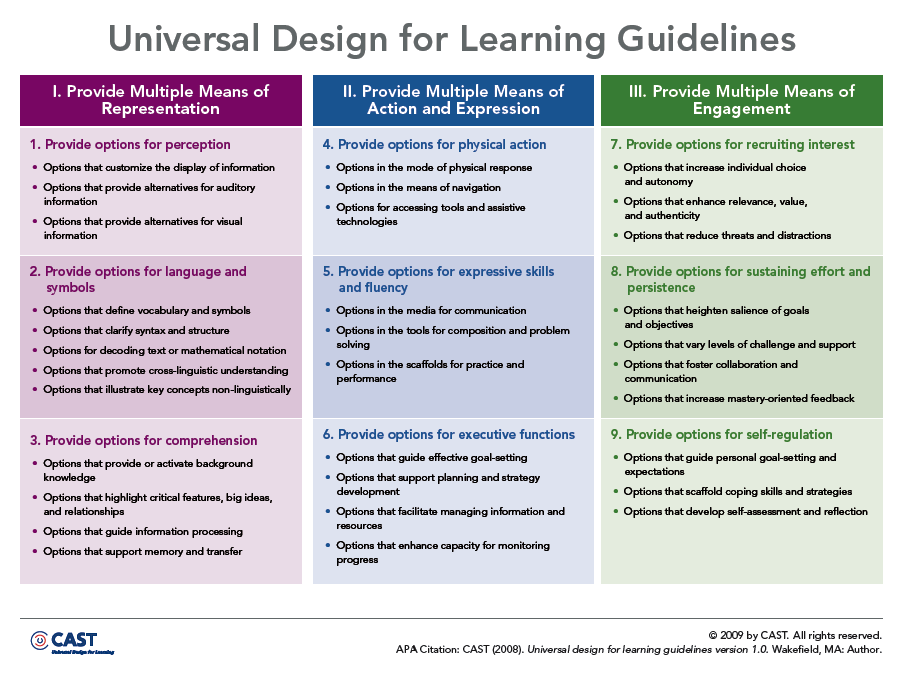
CAST (2008). Universal design for learning guidelines version 1.0. Wakefield, MA: Author.
Finally, improving inclusions also means embracing multiculturalism, including the Indigenous cultures, hence the way of evaluating students’ performance changes. According to Banks (2000):
Evaluating the progress of students from diverse racial, ethnic, and social-class groups is complicated by differences in language, learning styles, and cultures. Hence, the use of a single method of assessment will likely further disadvantage students from particular social classes and ethnic groups. (p. 12, as cited in Johnson & Fox, 2003, p. 11)
This document admits the importance of Indigenous culture and recognizes its difference instead of claiming to be cultureless. If teachers have little experience with Indigenous students and Indigenous culture, they cannot effectively help them, not to mention the students from other cultures (Ukpokodu, 2010). Therefore, cultural inclusion is beneficial to both pedagogy and curriculum evolution, and those changes contribute to a more inclusive curriculum that supports Indigenous students and other minority students.
Weaknesses
Although this document have considered essential aspects of an inclusive curriculum and intercultural education, it fails to mention the need for social reconstruction for equity and justice. First of all, it ignores the following questions regarding the people and the power relations involved:
- Who will be carrying out those plans?
- Are they teachers of colour or teachers from the Aboriginal community?
Those questions are essential because the calls to action should focus on adding what has been missed in education and identifying the invisible power inequity between the minority group and the dominant group. For instance, a survey in 2006 indicated that the racialized teacher population did not grow with the increasing population of racialized students (Ryan et al., 2009). Moreover, “another significant trend is that the proportion of ‘visible minority’ teachers in the teacher workforce has decreased relative to the proportion of ‘visible minority’ citizens in the Canadian population” (p. 597). Does it mean that teachers of colour are less qualified so they could not get employed? The truth is that “discriminatory practices in the labour force dictate that racialized group members do not get fair economic and occupational returns for their educational attainments” (Galabuzi, 2006, as cited in Ryan et al., 2009, p. 605). For instance, according to one of the participants in the study conducted by Ontario College of Teachers (2006), “there is an undeniable preference for non‐immigrant teachers over immigrated ones. This fact despite the experience and qualifications I hold” (p. 28, as cited in Ryan et al., 2009, p. 604).
The chart below presents the teacher diversity gap in 2014 in North America. For more information, click the link to read the article.
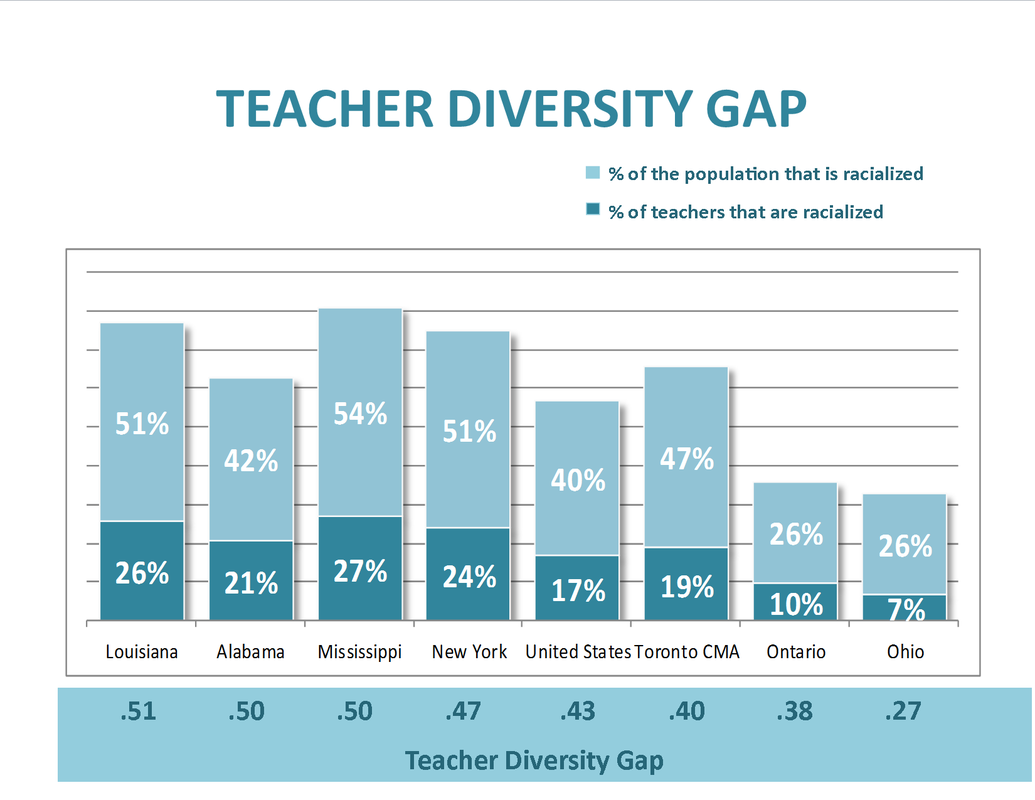
Teacher Diversity Gap by Tana Turner (2014): https://www.turnerconsultinggroup.ca/blog-tana-turner/teacher-diversity-gap
To address those issues, the government has established equity policies. However, some people view those policies as “new racism” as it might not reinforce their dominant positions (Nakhaie, 2013, p. 48). According to Nakhaie (2013), “individuals are influenced by both egalitarian norms and by deeply ingrained feelings against minorities. The first produces supportive attitudes towards race-targeted policies, and the second produces opposing views” (p. 59). Most people would assume that everyone, both racialized and non-racialized, has equal opportunities. This meritocratic ideology prevents critical scrutiny on “the myths of equality opportunity” (p. 60). For instance, Wetherell and Potter’s (1992, as cited in Nakhaie, 2013) found that, “the dominant white group used a range of arguments rooted on principles of fairness, equal opportunity, and individual rights in order to justify existing dominant subordinate racial inequities” (p. 49). As a result, those equity policies, including the Calls to Action, are mainly dependent on the dominant ideologies (Agocs, 2002) because they ignore the impacts of unequal power relations. Although the presence of a more diverse teaching workforce does not necessarily mean a more rich school culture, and some white teachers have done great jobs for teaching students of colour, they cannot “stand in a position to understand, communicate, or identify with students of colour the way educators of colour are able to do” (Ryan et al., 2009, p. 595). Consequently, intercultural education fails to reveal “the colonizing and dominating outcome of intergroup or intercultural dialogue” (Gorski, 2008, p. 8).
TRC Calls to Action # 92
We call upon the corporate sector in Canada to adopt the United Nations Declaration on the Rights of Indigenous Peoples as a reconciliation framework and to apply its principles, norms, and standards to corporate policy and core operational activities involving Indigenous peoples and their lands and resources. This would include, but not be limited to, the following:
i. Commit to meaningful consultation, building respectful relationships, and obtaining the free, prior, and informed consent of Indigenous peoples before proceeding with economic development projects.
ii. Ensure that Aboriginal peoples have equitable access to jobs, training, and education opportunities in the corporate sector, and that Aboriginal communities gain long-term sustainable benefits from economic development projects.
iii. Provide education for management and staff on the history of Aboriginal peoples, including the history and legacy of residential schools, the United Nations Declaration on the Rights of Indigenous Peoples, Treaties and Aboriginal rights, Indigenous law, and Aboriginal–Crown relations. This will require skills based training in intercultural competency, conflict resolution, human rights, and anti-racism.
Strengths
This document protects Indigenous people’s right and provides equitable access to education and employment, ensuring the mutual rights of Indigenous people and companies. The assimilationist ideology dominated the western nations in the 1960s and 1970s, which means a national goal in the United States, Canada, and Australia was to create a nation-state where the “Anglo-Saxon or Anglo-Celtic” was the dominant culture (Banks, 2009, p. 103). It forced the diverse groups to abandon their original culture and languages to be “qualified” citizens, attempting to “maintain their national identities and the cultural hegemony of existing dominant groups” (p.103). For avoiding the assimilationist ideology when communicating with Indigenous people, it is imperative to have meaningful discussions and interactions with them before and during related economic activities. Otherwise, the minority groups will become the victims of the “by-product of the hegemony of economic globalization” (Shultz, 2007, p.253). Therefore, providing “equitable access to jobs, training, and education opportunities” to Indigenous people while proceeding with economic activities is significantly essential.
Besides creating equitable opportunities, it is also important to promote diversity education for employees or people who will work in related positions to increase their awareness of anti-racism and intercultural competency. As the “assumption of fairness and the silencing of racialized minority history” contributes to maintaining the ideology of meritocracy (Denis & Schick, 2003, p. 60), It is necessary to question the assumption that Canada has been an equitable country by looking into the counter-histories like what happened to the freed African slaves and Chinese indentured labourers in Canada and the Indigenous students in the residential schools. By exploring those histories, people might find justified reasons, culturally or emotionally, to avoid the ideology of meritocracy (believing that there are equitable opportunities for everyone in Canada). Furthermore, it guides people to arrive at the basic elements of cultural competency: attitudes, knowledge, and comprehension (Deardorff, 2009). Only with those three elements would people become prepared for the internal outcome and income (2009), which means creating effective and meaningful interactions with racialized minority groups. Consequently, this document could ensure the mutual rights of Indigenous people and Canadian companies via creating a reciprocal situation for both groups.
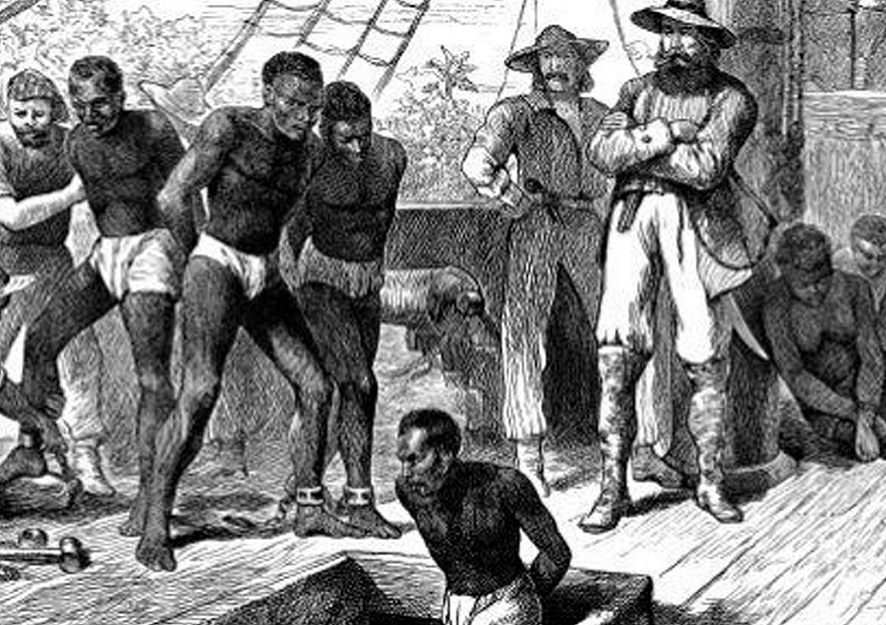
Black slaves lived in the British regions of Canada – public domain image
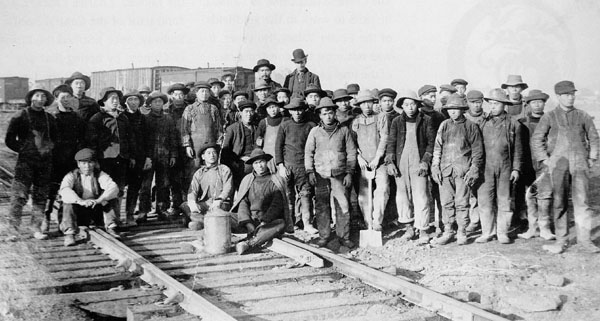
“a picture of the Chinese working on the Canadian Pacific Railway” by Gérard Dicks Pellerin : https://wenhenry.wordpress.com/tag/cpr/
Weaknesses
Even though education and employment opportunities will be created by those companies that are legally utilizing Indigenous people’s lands and resources, the “good intention” seems less powerful regarding creating equitable opportunities.
First, the essential problem is similar to the weakness of Calls to Action # 63 in that it does not emphasize the imbalanced power relation between the dominated and non-dominated groups (the companies and Indigenous people). Gorski (2008) posed a question, “Which people and systems do we protect when we request such empathy from dominated groups without first demanding equity and justice from the powerful?” (p. 8). In this fashion, the document, mentioning to provide employment and education opportunity in the corporate sector, sounds like an unfair trade that allows the companies to use the land and resources to give local people a chance to work due to their sympathy for those people. It also sounds like the Indigenous people do not know how to use their land and resources, so the people who run the Corporations need to help them, which is similar to what happened in the residential schools that were established to help the Indigenous family teach their children on how to behave properly as a “civilized” citizen (Indigenous Foundations, n.d.). According to Denis and Schick (2003), “This denial of unequal power normalizes and makes invisible both historical and current relations of inequality. Without naming relations of inequality based on race, racial inequality is assumed to be an explanation for disadvantage” (p. 62). Consequently, when companies claim to create equitable opportunities, power inequality must be justified and mentioned.
Second, the ideology of meritocracy that supported by people who believe that “Canada is a country of unlimited resources and opportunity, a nation to which immigrants have come to ‘make something out themselves,’ ” and the assumption that “everyone has equal opportunity because we are all basically the same; all that is required to get head is hard work, talent, and effort” (p. 63) ignores the “social, economic, historical, and political conditions” (Denis & Schick, 2003, p. 64).
The comics presents a concise history of Black-White relations in the U.S.A.
The reality is ironic. For instance, Ryan et al. (2009) find two factors that cause the decrease of racialized educators in teacher workforce: “(1) Inequitable schooling practices that limit the number of students willing and able to enter the teaching force. (2) Discriminatory licensing and hiring practices that exclude those who have already completed their teacher education programs” (p. 609). Their conclusion provide one possible situation in which those rules and standards set for equitable access could be subtly changed to include some groups while excluding the other groups under the name of equity and equability. In this sense, this document should be edited into a version that allows Indigenous people to have equal power in the conversation while respecting their decision to deal with their resources and develop sustainable and inclusive economic activities.
TRC Calls to Action # 57 & #93
#57
We call upon federal, provincial, territorial, and municipal governments to provide education to public servants on the history of Aboriginal peoples, including the history and legacy of residential schools, the United Nations Declaration on the Rights of Indigenous Peoples, Treaties and Aboriginal rights, Indigenous law, and Aboriginal–Crown relations. This will require skills based training in intercultural competency, conflict resolution, human rights, and anti-racism.
#93
We call upon the federal government, in collaboration with the national Aboriginal organizations, to revise the information kit for newcomers to Canada and its citizenship test to reflect a more inclusive history of the diverse Aboriginal peoples of Canada, including information about the Treaties and the history of residential schools.
Strengths
Both documents connect both newcomers and settlers in Canada with the Indigenous culture and heritages via raising their cultural awareness. they promote diversity, presenting that Canada is a diverse country and a multicultural society. People in the workplace, especially social workers or public servants, will know Indigenous culture and heritage, which helps them provide the corresponding service to Indigenous people. For new immigrants, they will be prepared with a diverse mindset indicating the attributes of Canadian society and the importance of Indigenous culture to Canada. Helping them overcome people’s potential fear and unfamiliarity is essential, as Guo (2012) states that,
Fear and unfamiliarity are exacerbated by curriculum and teaching practices in K-12 education, which are characterized by Eurocentric perspectives, standards and values, and do not reflect the knowledge and experiences of our culturally and religiously diverse student and parent population. (p. 6)
The education mentioned in the document can also guide people to reflect on their social location; hence, they would better understand the unfair situation faced by minorities. It is meaningful because some people are only taught to recognize what has been defined as racism (the act of unacceptable behaviors), but they do not identify the “interlocking oppressions” that are invisible in the system of society (McIntosh, 1990). With those procedures, Canada can prepare its people with a smooth shift of consciousness that brings positive influences on Indigenous people’s lives.
Weaknesses
However, raising cultural awareness is not enough, especially when cultural awareness largely focuses on cultural difference in the way that “justify dominance and oppression” from the “hegemonic norm” (Gorski, 2008, p. 10). For instance, the public servants mentioned in the documents would not effectively deal with conflict resolution if they do not have a chance to reflect on social justice. Since racism and prejudice come “from family, media, school, and friendship as the ideology of white supremacy seeps into our consciousness” (Brookfield, 2014, p. 94), the dominant group might commit unintentional “acts of exclusion and marginalization,” which is generally defined as micro-aggressions (Sue, 2010, as cited in Brookfield, 2014, p. 93). Thus, putting equity and social justice in place should be the basic rhythm for those documents, since the focus on cultural awareness is “exactly the kind of diversion in the name of interculturalism that serves the colonizing interests of the powerful” and the power hierarchy exists “even with our intercultural practice” (Gorski, 2008, p. 9).
Insights and Applications
The reflection on those documents is critical because no one is sure that the TRC Calls to Action symbolizes the end of that horrible history or a new one is beginning. Through my analysis, the most critical part is how to ensure the effectiveness and authenticity of this document, as it seldom mentions the need for social reconstruction. Can it lead toward reconciliation within Indigenous families? Can it guide and inspire a process of truth and healing? What if it is just an “undercover” and political strategy to protect the hegemony? What if the ideology of white supremacy still exists and use this document and people to justify its dominance?
Besides the residential school system and its legacy that needs to be resolved, Indigenous people, along with other minorities, also face other systemic injustices. Petoukhov (2011) states:
Residential schools comprise only a part of the colonial machine that has perpetuated oppression of Aboriginal people for many centuries and, if not brought to a halt, it may continue inflict further injustices for centuries to come. Without framing residential schools as a systemic issue, the TRC runs the danger of overlooking the roots of colonial structures that gave rise to not only residential schools, but to the many institutions that are operating based on stereotypes and unjustified assumptions of cultural inferiority of Aboriginal cultures and supremacy of Euro Canadian peoples. (p. 140)
From my previous working experience, the new immigrants have limited options when choosing a vocational training program that might lead to their future careers in Canada. Although those programs are tuition-free and open for all the new immigrants, their targeting jobs are those paying minimum wages. If new immigrants could not afford higher education, they might be passive to start a new career in Canada. Similarly, Indigenous people face the same issue. That is why the #63 and #92 in the document are significant to ensure equal educational opportunity and create more employment in a supportive way.
For my future implication and practice, I will locate myself and my “individual and collective histories,” critically reflect their “wider discourses and their associated power relation” (May & Sleeter, 2010, p.10), while raising people’s cultural awareness to Indigenous history and heritage. With the understanding of diversity, equity, and inclusion, I will provide meaningful support, which means considering the invisible power inequity and systematic problem, and accessible educational opportunities that guide students to find a satisfying career in Canada. Since 2019, Canada has only complete nine out of 94 Calls to Actions (Jewell & Mosby, 2019). The remarkably low completion rate means that there is still much work to be done.
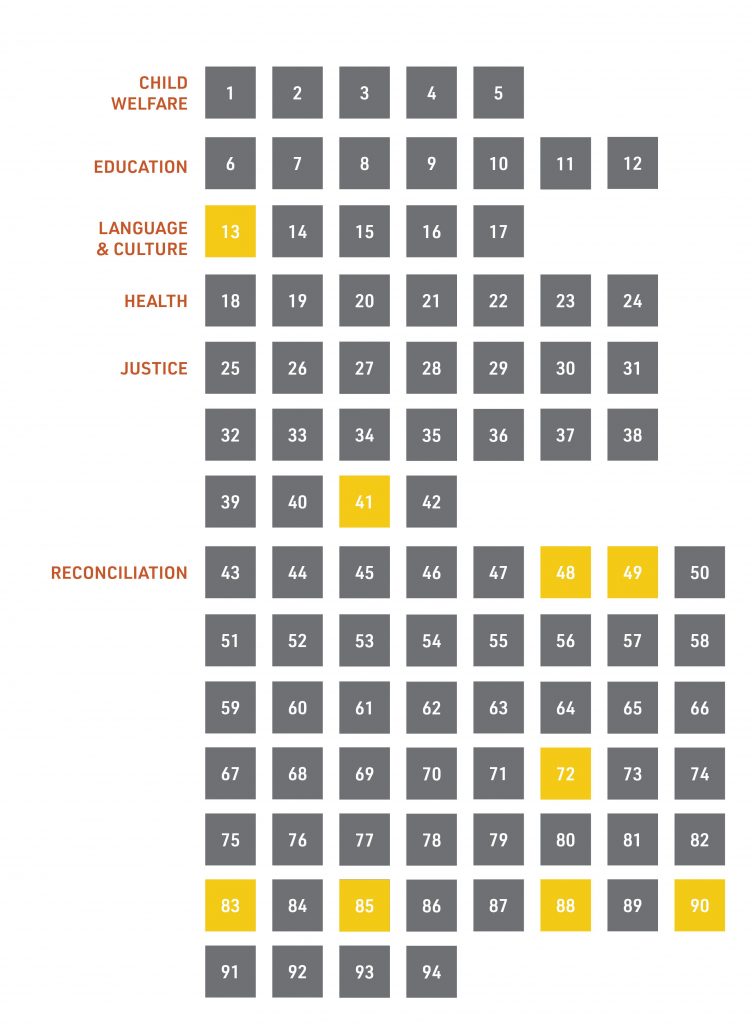
“In 2019, we are at a total of nine complete Calls to Action out of 94.” – https://yellowheadinstitute.org/2019/12/17/calls-to-action-accountability-a-status-update-on-reconciliation/
References
Agocs, C. 2002. Canada’s Employment Equity legislation and policy, 1986-2000: Unfulfilled promises. In Workplace Equality: International Perspectives on Legislation, Policy and Practice, ed. C. Agocs, 65-90. New York: Kluwer Law International.
Alfred, T. (2009). Restitution is the Real Pathway to Justice for Indigenous Peoples. In J. D. Younging & M. Degagné (Eds.), Response, Responsaibility, and Renewal (pp. 179-187). Ottawa, Canada: Aboriginal Healing Foundation.
Banks, J. A. (2009). Human rights, diversity, and citizenship education. Educational Forum, 73(2), 100-110. doi:10.1080/00131720902739478
BiblioArchives. (2005). Aboriginal students with a dog on the steps of an Indian School near Woodstock, New Brunswick / Élèves autochtones sur les marches d’une école indienne, avec un chien, près de Woodstock (Nouveau Brunswick). https://www.flickr.com/photos/lac-bac/14096934129/
Brookfield, S. (2014). Teaching our own racism: Incorporating personal narratives of whiteness
Canadian Ethnic Studies, 45(1/2), 43-67.
CAST. (2008). Universal Design for Learning Guidelines. http://udlguidelines.cast.org/
Darla K Deardorff: (2009) Exploring interculturally competent teaching in social sciences classrooms. Enhancing Learning in the Social Sciences 2(1), DOI: 10.11120/elss.2009.02010002
Gérard Dicks Pellerin. (n.d.). a picture of the Chinese working on the Canadian Pacific Railway. https://wenhenry.wordpress.com/tag/cpr/
Gorski, P. C. (2008). Good intentions are not enough: A decolonizing intercultural education. Intercultural Education, 19(6), 515-525. doi:10.1080/14675980802568319
Indigenous Foundations. (n.d.). The residential school system. Welcome to Indigenous Foundations. https://Indigenousfoundations.arts.ubc.ca/the_residential_school_system/
into anti-racist practice. Adult Learning, 25(3), 89-95
Jewell, & Mosby. (2019, January 15). Calls to action accountability: A status update on reconciliation. Yellowhead Institute. https://yellowheadinstitute.org/2019/12/17/calls-to-action-accountability-a-status-update-on-reconciliation/
Johnson, D.M. & Fox, J.A. (2003). Creating curb cuts in the classroom: Adapting universal design principles to education. In J.L. Higbee (Ed). Curriculum transformation and disability: Implementing universal design in higher education. Minneapolis, MN: University of Minnesota.
May, S., & Sleeter, C. E. (2010). Introduction. In S. May & C.E. Sleeter (Eds.). Critical multiculturalism: Theory and praxis. Routledge: New York, N.Y., pp.1-16.
McIntosh, P. (1989). White Privilege: Unpacking the Invisible Knapsack Peace and Freedom, 9-10; repr. in Independent School, 49 (1990), 31–35.
Nakhaie, R. (2013). Ideological orientation of professors and equity policies for racialized minorities.
Petoukhov, K. (2011). An Evaluation of Canada’s Truth and Reconciliation Commission (TRC) through the Lens of Restorative Justice and the Theory of Recognition. Department of Sociology, University of Manitoba.
Ryan, J., Pollock, K., & Antonelli, F. (2009). Teacher diversity in Canada: Leaky pipelines, bottlenecks, and glass ceilings. Canadian Journal of Education, 32(3), 43- 67
Shultz, L. (2007). Educating for global citizenship: Conflicting agendas and understandings. Alberta Journal of Educational Research, 53(3), 248-258.
Ted’s photos. (2018). 2018 – Vancouver – National Indigenous Day Drummer.
The People’s School of DC. (2019, September 2). Myth of meritocracy. The People’s School of DC. https://peoplesschooldc.wordpress.com/myth-of-meritocracy/
Truth and Reconcilliation Commission of Canada. (2015). Honouring the truth, reconciling for the future: Summary of the final report of the truth and Reconcilliatiom commission of Canada. CreateSpace.
Turner, T. (2014). Teacher diversity gap. TURNER CONSULTING GROUP INC. https://www.turnerconsultinggroup.ca/blog-tana-turner/teacher-diversity-gap
York-Barr, J., & Vandercook, T. (1996). The evolution of inclusive education. Impact, 9(2), 2-3.

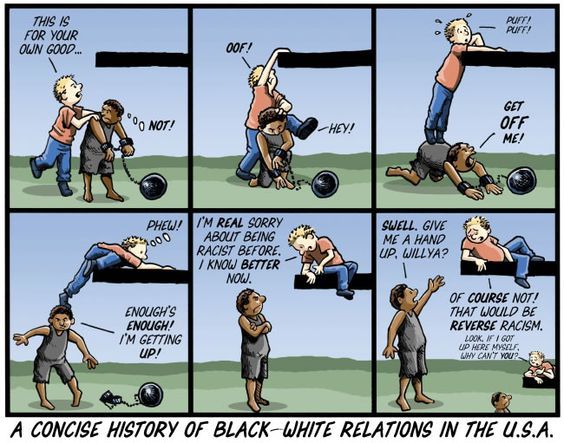

Georgann Cope Watson
This is an amazing critical analysis that unpacks some of the Calls to Action. I hope others get a chance to see this analysis.
Georgann
Junxiang
Hi Georgann, thanks for your comments.